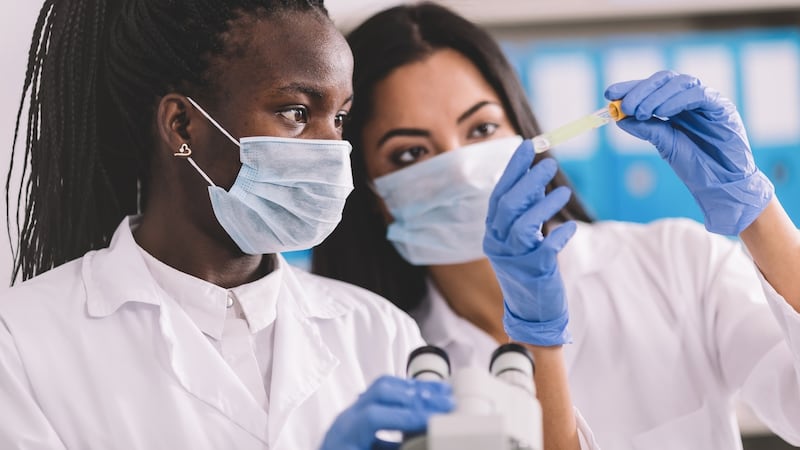Covid-19 is mercurial. When it first emerged in humans, we soon saw that it hits the lungs hard: the virus and our body’s response to the virus can destroy all-important tissues in our airways. But then came other symptoms in some patients who had the infection: kidney damage, heart problems and strokes. While the lungs might be a gateway, Covid-19’s reach can extend much further into the body in some cases, and scientists are trying to figure out why.
It became clear from from early on that something was up with the blood in patients with the disease, says Prof James O’Donnell, a consultant haematologist at St James’s Hospital and director of the Irish Centre for Vascular Biology.
"When this virus came on the scene, people were expecting it to be a regular pneumonia, where you get infection in the lungs, and the air-sacs or alveoli deep in the lungs fill with pus," he says. "But even in Wuhan, where we saw the disease first, some patients had signs that their blood coagulation was active, which is a sign of injury to the blood vessels. We see this kind of response in various infections, but not as dramatically as we have seen in Covid-19. And the patients who had high levels of coagulation activation were not doing well."
When O’Donnell and colleagues looked into it, they found another clue that something was up with the blood: they examined blood samples collected from Irish patients with confirmed Covid-19 infection and saw an unusual pattern of abnormal blood clotting. In addition, the extent of this abnormal clotting was able to predict poor clinical outcomes in those Irish patients. They published their findings in late April in the British Journal of Haematology.
"These results are interesting, because other researchers internationally have carried out autopsies of patients who had severe Covid-19 and have shown that the small blood vessels in the lungs were full of microthrombi or tiny blood clots," says O'Donnell, who is Professor of Vascular Biology at the Royal College of Surgeons in Ireland and George Gabriel Stokes Professor of Haematology at Trinity College. "So we think that in severe Covid-19, not only can the patient not get enough oxygen into the lungs, there is another problem because the blood vessels around the air sacs are being blocked by clots, so the blood can't bring oxygen to other parts of the body. That would tie in with patients having such low oxygen levels."
Endothelial cells
Prof O’Donnell and colleagues are now focusing on endothelial cells, which form a thin layer on the inner surface of blood vessels. They think these important cells could be a key player in Covid-19.
“There is pretty good evidence in the literature now that endothelial cells can become extremely disrupted in Covid-19,” says O’Donnell. “One reason for this could be that they have on their surfaces the ACE-2 receptor that the Covid-19 viruses uses to access the inside of the cell, so the virus has a way to infect them. Normally endothelial cells function to keep clotting in check, so if these cells become disrupted, that could be one reason why we see so many clots.”

There’s also the ubiquity: blood vessels and their endothelial cell linings are present throughout the body, and O’Donnell thinks this might help explain how so many different tissues and organs can be damaged by Covid-19.
“If you have a lack of oxygen due to the double-whammy of lung damage and poor blood circulation from the lungs, this can have a knock-on effect on endothelial cells in other parts of the body,” says O’Donnell. “Endothelial cells can also get damaged by immune responses that the body mounts to the virus, too.”
He is now leading the Irish Covid-19 Vasculopathy Study, funded by the Irish Research Council and the Health Research Board. "We want to find out more about what is happening in Covid-19 at endothelial cell level, and we are trying to work out why some patients have such a mild illness and others have a progressive and problematic course."
The goal is to identify patients who are at high risk of that problematic course in Covid-19 and to protect and treat them accordingly, says O’Donnell. “It’s a complicated disease, and while there are many trials ongoing around the world to see if blood-thinners can address the clotting in Covid-19, the treatment may not be as simple as that, we need to know how to target and treat the endothelial cells if that is where the issue is.”
Immune response
Prof Garret A FitzGerald, Director of the Institute for Translational Medicine and Therapeutics at the University of Pennsylvania, agrees that blood thinners alone may be too far downstream to treat the problem. Like O’Donnell, he is looking at process of how blood vessels and endothelial cells get damaged in the first place in Covid-19.
FitzGerald and colleague Wen-Chao Song reckon an immune response called complement activation is part of the problem, where the body releases a suite of molecules into the bloodstream to fight an attacker - in this case the virus - but those molecules can damage the body’s own tissues too.
“I think the cardiovascular syndrome we see in Covid-19 has complement activation written all over it,” says FitzGerald, who is now planning studies to see what happens when you block that immune response.




















